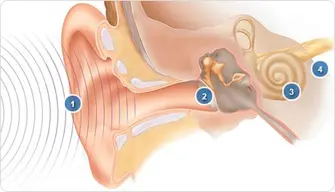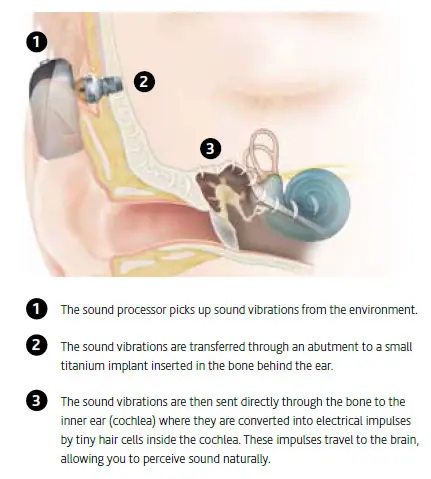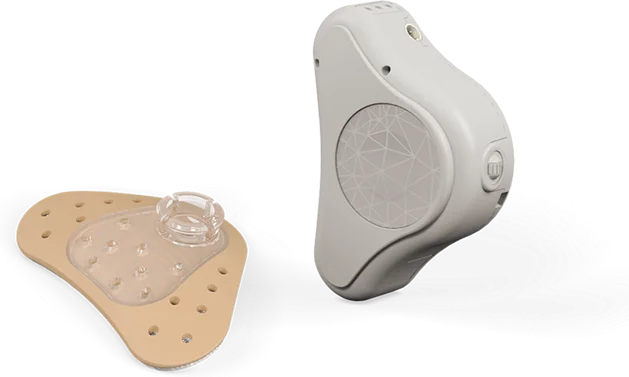Bone Conduction Hearing Devices in Dallas, Fort Worth, Frisco, TX
At Dallas Ear Institute, we believe our patients should have options when considering hearing amplification. Our team participates in ongoing clinical trials and research projects, allowing us to offer leading technology and stay abreast of advancements.
How We Hear

Before understanding how bone conduction systems work, it is important to understand the structure of the ear and how the natural pathway to hearing works. Sound waves enter the ear canal and impact the ear drum (tympanic membrane). The ear drum transmits sound wave vibrations through the chain of three middle ear bones known as the malleus, incus and stapes. The stapes passes the vibrations to the inner ear fluids within the cochlea (hearing organ). Fluid waves travel through the cochlea, bending the cochlea hair cells as it goes by. There are three types of active bone conduction systems are currently available.
- Sounds enter the ear canal and travel to the eardrum.
- These sound waves cause the eardrum to vibrate, setting the bones in the middle ear into motion.
- This motion is converted into electric impulses by tiny hair cells inside the inner ear (cochlea).
- These impulses are sent to the brain, where they are perceived by the listener as sound.
Bone Conduction Hearing
Bone, like air, can also conduct sound vibrations. The body has the ability to transfer sound using the skull bone to the inner ear (cochlea). This pathway to perceive sound is called bone conduction.
When problems exist in the outer or middle ear, they can prevent or limit the flow of sound waves, restricting the sound waves from effectively conducting to the inner ear. In these cases, a bone conduction system is a solution that bypasses the outer and middle ear to send sound vibrations through the skull bone to the inner ear to provide hearing.
Who Can Benefit From a Bone Conduction System?
Patients with chronic middle ear conditions, outer ear problems, and congenital defects of the ear who cannot wear conventional hearing aids may be candidates for a bone conduction system.
Types of Bone Conduction Systems
Active Bone Conduction Systems
In an active bone conduction system, an implant is surgically placed in the bone behind the impaired ear and the skin fully heals over the implant. The external sound processor is held comfortably in place with a magnetic connection. The external sound processor picks up sound waves and transfers the signal to the implant. With an active transcutaneous bone conduction system, the sound vibrations are created directly by the implant and not by the external sound processor. Two types of active bone conduction systems are the Cochlear Osia and MED-EL Bonebridge.
Download Postoperative Care Instructions
Bone Anchored Hearing Systems
A bone anchored hearing system consists of:
- A small titanium implant that is surgically placed in the bone behind the impaired ear, which with time, will integrate into the bone.
- An abutment, which is the end of the implant that sticks out through the skin.
- A small sound processor that attaches to the abutment of the implant.

The sound processor picks up sound waves via a microphone, transforms the received sounds into sound vibrations and sends them via the abutment and integrated implant through the skull to stimulate the inner ear.
The implant allows a direct connection between the sound processor and the bone (percutaneous bone conduction). This direct connection maintains the conduction of the sound, since the sound does not have to pass through skin and muscle, which can weaken the sound.
The bone anchored implant is FDA approved for children over the age of 5. The surgery is safe and simple. It is a proven and viable solution to helping people that cannot benefit from or use traditional hearing aids. It been used for over 40 years with about 200,000 individuals worldwide having been implanted with this hearing solution.
Download Bone Anchored Post Operative Instructions
Non-surgical Bone Conduction Systems
Non-surgical bone conduction systems are suitable for individuals who are unwilling to undergo a surgery, individuals who do not meet minimum age requirements for surgery, individuals who may be faced with other surgeries that need to be prioritized (e.g., craniofacial procedures), or individuals who have a conductive hearing loss of uncertain duration that may ultimately resolve.
There are different non-surgical bone conduction options such as a softband option, hard headband option, or adhesive option (MED-EL ADHEAR).
Softband
The adjustable softband is simply worn around the head. When the sound processor is attached, it sends sound waves through the bone to the inner ear. The band is a soft, skin-friendly and non-allergenic material that can be adjusted for a close fit, designed to withstand the wear and tear of a child’s daily life while providing access to sounds for acquisition of speech and language.
Cochlear Soundarc
The Cochlear SoundArc is a hard headband with a modern look and easily adjustable for a secure and comfortable fit. It is simply worn across the back of the head with the sound processor positioned behind the ear, sending sound waves through the bone to the inner ear.
Oticon Medical – Ponto for Children
MED-EL ADHEAR

ADHEAR is a novel, effortless bone conduction option. This non-surgical bone conduction system consists of two parts: a hearing device and an adhesive adapter. The thin adhesive adapter is placed on the skin behind the ear and can be easily replaced every 3 to 7 days. The hearing device snaps onto the adhesive adapter. Its microphones pick up sound and vibrates the adhesive adapter to transmit the sound through the skin to the bone on to the inner ear. This highly innovative technology provides transmission of sound without pressure on the skin.

